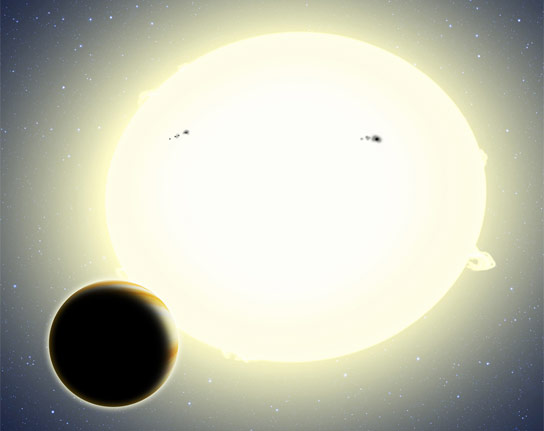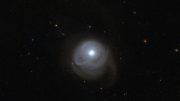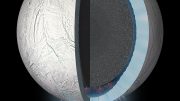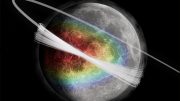
Einstein’s exoplanet, Kepler-76b, is a Jupiter-sized planet discovered using an effect of Einstein’s relativity. It orbits its star every 1.5 days. Credit: David A. Aguilar, CfA
Researchers used the BEEER algorithm to identify a hot Jupiter in the Kepler light curve, Kepler-76b.
Eight hundred and eighty nine exoplanets (planets around stars other than our Sun) have been discovered to date. Most of them were found using the Kepler satellite, which spots small dips in a star’s light as an orbiting planet periodically blocked our view (a “transit”). The satellite recently halted its operations due to a faulty gyroscope, and so its mission could possibly be over, but there remain a large dataset of possible other exoplanets for study. Meanwhile, NASA has selected a new mission for development: TESS (the Transiting Exoplanet Survey Satellite), on which CfA astronomers, who have played active roles in exoplanet research, continue their leadership.
The Kepler dataset has been steadily mined for transiting planets. In a dramatic first, CfA astronomer Dave Latham and four of his colleagues have discovered a new planet in the Kepler data by searching not for transits but for a less well-known effect of Einstein’s relativity: relativistic beaming. (Latham is being honored this week with a conference entitled, “Exoplanets in the Post-Kepler Era.”)
The effect can occur when an orbiting planet induces a slight wobble in the star’s motion with a corresponding modulation of stellar brightness. The effect in an exoplanet context was first predicted by two CfA astronomers in 2003, Avi Loeb and Scott Gaudi, in a paper the referee claimed would never lead to practical results; the variation in the brightness is typically only a few parts per ten thousand.
The new planet has a mass about twice that of Jupiter, orbits its star every 1.5 days, and (thanks to follow-up observations using other observatories) has a hot atmosphere with fast-moving jet-stream winds. The new result not only adds another exoplanet to the growing catalog, it demonstrates the ability of relativistic effects to discover and study exoplanets, and the power of very high-precision stellar monitoring.
Reference: “BEER analysis of Kepler and CoRoT light curves: I. Discovery of Kepler-76b: A hot Jupiter with evidence for superrotation” by Simchon Faigler, Lev Tal-Or, Tsevi Mazeh, Dave W. Latham and Lars A. Buchhave, 12 June 2023, The Astrophysical Journal.
DOI: 10.1088/0004-637X/771/1/26









Be the first to comment on "Kepler-76b: A Hot Jupiter With Superrotation"